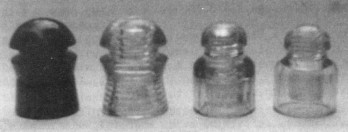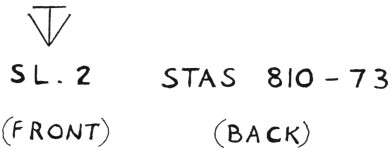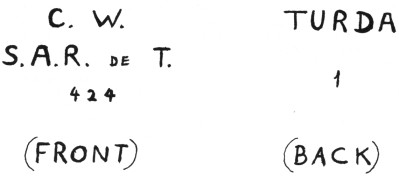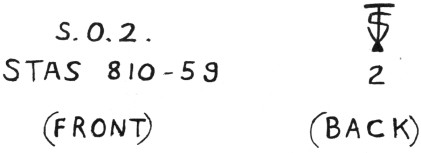Foreign Insulators
by Marilyn Albers
Reprinted from "Crown Jewels of the Wire", December 1980, page 4
Facts and Finds from Rumania and Kenya, East Africa
I just returned from the Bakersfield Show October 10-11 in California. That
was one fine show! There were well over 50 sales tables loaded with all sorts of
insulators, and 11 excellent displays. The weather was perfect, and this, I'm
sure, contributed to the fact that walk in traffic was heavy. Thanks to Dee
Willett and Jerry Gibby, the show was well advertised. Jerry, you did a great
job of putting the show together. You get an A+ on that one!
Robert Chiantelli (Monterey, Cal.) was there with a great number of
Australian insulators, several of which went home with me as new additions to my
collection. He's so enthusiastic about what's available over there in Australia
that he's returning to Alice Springs in May.
Gene Calman (San Diego, Cal.) was also at the show with a large display of
foreign glass and porcelain, plus a sales table full of duplicates he has from
Bulgaria, Spain, Portugal, East and West Germany, Rumania, Belgium, Greece,
Turkey, France, England and Norway. He has some honest to goodness red
porcelains from a fire line in Norway -- just fantastic! He spent two and a half
months in Europe this past summer, as he has several times before.
Along with
four glass insulators from Rumania that I bought from Gene, he passed on some
excellent information that he managed to find out about them while he was over
there. Most of this had come by means of a letter he wrote to me during the
summer, parts of which I will quote:
"Got a lot of stuff in Rumania -- 2 or 3
of the larger style that you have (acquired from him at last year's Bakersfield
Show) and a few of the smaller. They were produced at S.A.R. DE TURDA. Societe A
(means something "independent") R - Rumania. STAS means
"Type". 810-59 may or may not mean much. I thought that 810 would be
model number, but it appears on both sizes of insulators. The glass factory no
longer produces insulators, and hasn't for 15 years or so. Its name is "STICLA
TURDA" (Turda is the name of a town in central Rumania.). STICLA means
glass works, apparently. There is also a porcelain works in Turda.
"I got 6
or 7 new ones from "INTREPINDEREA DE STICLAIRE" in TIRGUE JIU. These
are a very nice emerald green and are quite similar to the larger of the old
ones but are a little shorter, and the skirt is about 1/2 inch thick. They also
don't have the swirls (thread) on the skirt as do the older ones. Markings on
both styles are on the lower skirt."

The insulator on the far left
is the emerald green. The threads are spaced 1/4 inch apart and come down about
half way on the inside of the skirt. The pinhole appears to be standard American
size, and there is no inner skirt. This beautiful insulator is the newer one
Gene referred to. See embossing below.

The insulator second from left in the
picture is the older style. The measurements are nearly the same (4-1/4 inches
high by 2-3/4 inches across base) as the newer model, but instead of emerald
green, the color is a pretty blue-aqua. There is no inner skirt. The threads on
this insulator are also widely spaced and go all the way down the skirt on the
inside. The pinhole is, again, normal size, and the embossing is on the lower
skirt. Gene has this same insulator in his collection in a pretty peach color.
Embossing follows.

The insulator second from right is blue-aqua, measures
4 inches high and 2-5/8 inches across the base. I think its shape is really
unique. It looks so European! The pinhole in this one is slightly smaller (3/4
inch) than in an American insulator of comparable size (1 inch). The threads
also look more "normal", not so humongous and widely spaced as on the
other two. There is an inner skirt, and the embossing is on the outer skirt near
the base.

The last insulator, far right, is just about the same regarding shape,
color, size and embossing, with these exceptions: it is 3/4" shorter, and
the logo of the glass factory "STICLA TURDA" is a bit different, as
you can see.

(All the embossings have been reduced in these copies.)
All four
insulators are very unique, and I'm proud to have them. Thanks, Gene!
On to West
Germany and a letter from Wayne and Dolores Dixon who live in Weisbaden. They
write: "We were pleased to see the German Bundesbahn (railroad) insulator
in the May 1980 issue of Crown Jewels. One correction, though. This is not a
power insulator. It is used for railroad communication."
I'm positive
you're right, Dolores, now that you and Gene Calman have straightened me out
about it. Guess my confusion came from seeing this exact same size and style
used on lines supplying power to Swiss trains and ski lifts -- that, plus knowing
European trains are electric. But we ask dual duty of some styles of insulators
here in the U.S.A., too -- whatever seems to be handiest to the lineman! In La
Grange, Texas, running through some pasture land we own are some old telegraph
poles with the lines down. These run right along the railroad track. You
wouldn't believe the strange combination of telephone, telegraph and power
insulators all sharing the same crossarm!
You also expressed surprise
that there would still exist in West Germany any insulators with human hair
inside the pinhole (September '80 Crown Jewels article on German insulators).
The insulators I wrote about were taken out of Germany right after World War II
and remained in the farmer's yard for all these years, until Brent Burger wrote
to me about them -- sort of like Mother Nature's Museum.
Switching subjects again,
remember my telling you about the little green glass insulator -- E.S.A. /NEXO-6
? -- the one manufactured in Spain, but supposedly found in Africa, but we really
never knew for sure where in Africa, other than Spanish Morocco?
Dolores gave me
some more leads on this one, and I quote again from her letter:
"In January
1979 when we were vacationing in Africa we found an E.S.A./NEXO-6 in a scrap
heap in a telephone company pole yard in MOMBASSA, KENYA. We were told that the
crews were in the process of replacing all of the NEXO-6's because they were
nearly useless as telephone insulators (I wonder why?). It is Wayne's opinion
that they probably were originally manufactured for power since they were being
used in Morocco according to the Harder letter (see May '80 issue of Crown
Jewels). Now we all know that Morocco was once part of Spain, but Kenya was
never anything but British, before independence. Wayne salvaged a total of 4
insulators from that scrap heap, under the watchful eyes of an uneasy telephone
company supervisor. Two were white porcelain from the G.P.O. (General Post
Office) in England, one was the NEXO-6 dark green glass, and the other a small
purple glass (slurp!!), origin unknown. He had previously come home with one
white porcelain from the now defunct East African Railway (I shouldn't say
'defunct', I should say 'nationalized' and changed to Kenya Railway). It was
found in a railroad yard in Nairobi and also came from England"
Thanks,
Dolores, for all that good input. I'll tell you what, though -- I'd give my kingdom
(almost) to know what NEXO means. One day I'll bark up the right tree!
In
Herkimer, New York, this past summer at the National I met Bob Burley from
Ontario, Canada. He walked into the show with a NEXO-6 insulator he'd also found
in Kenya in 1976. He made a trip over there, landed in Nairobi, and from there
went to Mombassa on the Indian Ocean or west coast of Kenya. Near here is where
he found the NEXO-6 insulators. He was riding a bus along the ocean coast and
saw telephone lines down, with some insulators lying on the ground. The area was
rather remote, and it was really rare to find telephone lines at all, but they
were there to connect resort areas along the coast. Since the bus driver
wouldn't stop for such a silly thing (oh the pain of it all!), he had to try to
remember where along the route he'd seen them, and he ended up walking back to
get them. I think my notes are right, Bob, didn't you tell me it was 15 miles?
Pure and utter devotion to the hobby, I'd say! He also found some white
porcelain telephone insulators from England, which adds up, since Kenya was
British owned at one time. But little old NEXO-6, we're getting you surrounded!
And hey out there, does anyone know (or know of anyone else who might know) what
NEXO stands for? In the meantime I really feel it's safe to say that the NEXO-6
and the CD 755 NEXO-5 ("from Africa", according to Milholland) were
used in Spanish Morocco and Kenya.
| 